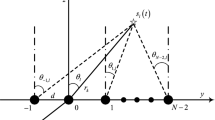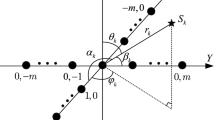Abstract
In this paper, a novel algorithm is presented for estimating three-dimensional (3-D) parameters of near-field (NF) sources with a centro-symmetric cross array, where the sub-array x and the sub-array y are uniform linear arrays equipped with the same number of array elements. By exploiting the time-delay-based spatial correlation of the received signal, the proper array elements are selected, respectively, from the two sub-arrays to define two sets of variables, and then two time-delay-based vectors are constructed. Further, a series of delay lags are uniformly sampled to form pseudo snapshots so as to obtain two corresponding time delay matrices, which facilitates the formation of the parallel factor (PARAFAC) model in time domain. Finally, trilinear alternating least squares decomposition is utilized to jointly estimate the two-dimensional (2-D) direction-of arrival and range parameters of NF sources from the PARAFAC model. In the case of low signal-to-noise ratio and small snapshots conditions, the estimation performance in the 3-D parameters of the proposed algorithm is superior to that of the subspace-based algorithm. In addition, the proposed algorithm only involves simple parameter pairing, which requires no eigenvalue decomposition and spectral peak searching.





Similar content being viewed by others
Data availability
The data included in this study may be available upon reasonable request by contacting with the corresponding author.
References
K. Abed-Meraim, Y. Hua, 3-D near field source localization using second order statistics. In: Conference Record of the Thirty-First Asilomar Conference on Signals, Systems and Computers (Cat. No.97CB36136), vol. 2, vol. 2 (1997), pp. 1307–1311. https://doi.org/10.1109/ACSSC.1997.679115
R.N. Challa, S. Shamsunder, Passive near-field localization of multiple non-gaussian sources in 3-D using cumulants. Sign. Process. 65(1), 39–53 (1998). https://doi.org/10.1016/S0165-1684(97)00206-5
H. Chen, Z. Jiang, W. Liu, Y. Tian, G. Wang, Conjugate augmented decoupled 3-D parameters estimation method for near-field sources. IEEE Trans. Aerosp. Electron. Syst. 58(5), 4681–4689 (2022). https://doi.org/10.1109/TAES.2022.3164864
H. Chen, W. Wang, W. Liu, Joint doa, range, and polarization estimation for rectilinear sources with a cold array. IEEE Wirel. Commun. Lett. 8(5), 1398–1401 (2019). https://doi.org/10.1109/LWC.2019.2919542
K. Deng, Q. Yin, Closed form parameters estimation for 3-D near field sources. In: 2006 IEEE International Conference on Acoustics Speech and Signal Processing Proceedings, vol. 4, (2006), pp. IV–IV. https://doi.org/10.1109/ICASSP.2006.1661173
J. He, L. Li, T. Shu, T.K. Truong, Mixed near-field and far-field source localization based on exact spatial propagation geometry. IEEE Trans. Veh. Technol. 70(4), 3540–3551 (2021). https://doi.org/10.1109/TVT.2021.3065954
J. He, T. Shu, L. Li, T.K. Truong, Mixed near-field and far-field localization and array calibration with partly calibrated arrays. IEEE Trans. Sign. Process. 70, 2105–2118 (2022)
Z. Jiang, H. Chen, W. Liu, G. Wang, 3-D temporal-spatial-based near-field source localization considering amplitude attenuation. Sign. Process. 201, 108735 (2022). https://doi.org/10.1016/j.sigpro.2022.108735
Z. Li, J. Shen, H. Zhai, X. Zhang, 3-D localization for near-field and strictly noncircular sources via centro-symmetric cross array. IEEE Sens. J. 21(6), 8432–8440 (2021). https://doi.org/10.1109/JSEN.2020.3048713
J. Liang, D. Liu, Passive localization of near-field sources using cumulant. IEEE Sens. J. 9(8), 953–960 (2009). https://doi.org/10.1109/JSEN.2009.2025580
D. Nion, N.D. Sidiropoulos, Tensor algebra and multidimensional harmonic retrieval in signal processing for MIMO radar. IEEE Trans. Sign. Process. 58(11), 5693–5705 (2010). https://doi.org/10.1109/TSP.2010.2058802
J. Shi, F. Wen, T. Liu, Nested mimo radar: Coarrays, tensor modeling, and angle estimation. IEEE Trans. Aerosp. Electron. Syst. 57(1), 573–585 (2021). https://doi.org/10.1109/TAES.2020.3034012
F. Wen, G. Gui, H. Gacanin, H. Sari, Compressive sampling framework for 2d-DOA and polarization estimation in mmWave polarized massive MIMO systems. IEEE Trans. Wirel. Commun. (2022). https://doi.org/10.1109/TWC.2022.3215965
F. Wen, J. Shi, G. Gui, H. Gacanin, O.A. Dobre, 3D positioning method for anonymous UAV based on bistatic polarized MIMO radar. IEEE Internet of Things J. (2022). https://doi.org/10.1109/JIOT.2022.3204267
F. Wen, J. Shi, Z. Zhang, Joint 2D-DOD, 2D-DOA, and polarization angles estimation for bistatic EMVS-MIMO radar via PARAFAC analysis. IEEE Trans. Veh. Technol. 69(2), 1626–1638 (2020). https://doi.org/10.1109/TVT.2019.2957511
X. Wu, W.P. Zhu, Single far-field or near-field source localization with sparse or uniform cross array. IEEE Trans. Veh. Technol. 69(8), 9135–9139 (2020). https://doi.org/10.1109/TVT.2020.2998128
X. Zhang, W. Chen, W. Zheng, Z. Xia, Y. Wang, Localization of near-field sources: a reduced-dimension music algorithm. IEEE Commun. Lett. 22(7), 1422–1425 (2018). https://doi.org/10.1109/LCOMM.2018.2837049
Z. Zheng, M. Fu, W.Q. Wang, H.C. So, Symmetric displaced coprime array configurations for mixed near- and far-field source localization. IEEE Trans. Antennas Propag. 69(1), 465–477 (2021). https://doi.org/10.1109/TAP.2020.3005203
Z. Zheng, M. Fu, W.Q. Wang, S. Zhang, Y. Liao, Localization of mixed near-field and far-field sources using symmetric double-nested arrays. IEEE Trans. Antennas Propag. 67(11), 7059–7070 (2019). https://doi.org/10.1109/TAP.2019.2925199
W. Zuo, J. Xin, N. Zheng, A. Sano, Subspace-based localization of far-field and near-field signals without eigendecomposition. IEEE Trans. Sign. Process. 66(17), 4461–4476 (2018). https://doi.org/10.1109/TSP.2018.2853124
Acknowledgements
This research was supported by Zhejiang Provincial Natural Science Foundation of China under Grants No. LY23F010003, LQ21F010006 and LY21F050003, and by the National Natural Science Foundation of China under Grants 62001256 and 62101289, and by Key Laboratory of Intelligent Perception and Advanced Control of State Ethnic Affairs Commission under Grant MD-IPAC-2019102, and by the Student Research and Innovation Program (SRIP) of Ningbo University under Grant No. 2023SRIP1317.
Author information
Authors and Affiliations
Corresponding authors
Ethics declarations
Conflict of interest
The authors declare that they have no conflict of interest.
Additional information
Publisher's Note
Springer Nature remains neutral with regard to jurisdictional claims in published maps and institutional affiliations.
Rights and permissions
Springer Nature or its licensor (e.g. a society or other partner) holds exclusive rights to this article under a publishing agreement with the author(s) or other rightsholder(s); author self-archiving of the accepted manuscript version of this article is solely governed by the terms of such publishing agreement and applicable law.
About this article
Cite this article
Wang, W., Zhao, T., Dong, H. et al. Spatial–Temporal-Based 3-D Parameters Estimation Method for Near-Field Sources Using Parallel Factor Model. Circuits Syst Signal Process 42, 6367–6378 (2023). https://doi.org/10.1007/s00034-023-02414-2
Received:
Revised:
Accepted:
Published:
Issue Date:
DOI: https://doi.org/10.1007/s00034-023-02414-2




